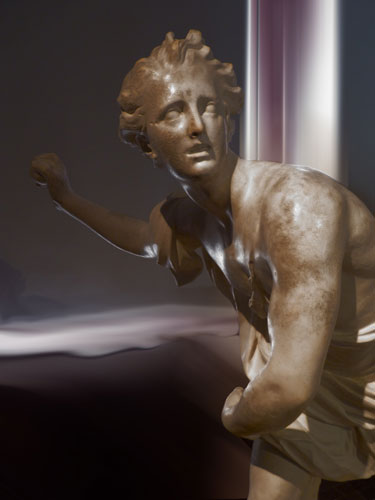“Sculpted Movement” exhibition
Posted in Exhibitions on 24 October 2011

From 27 October 2011 until 30 April 2012
Museo Tattile Statale Omero, Via Tiziano 50
Inauguration Thursday 27 October, 6 pm
In memory of Roberto Farroni who worked very hard to realise this exhibition, the fruit of years of collaboration with the Louvre.
The way the human body moves, its strength, grace, potential energy, sensuality, calm has been a major theme of art for centuries and has naturally found powerful expression in the field of sculpture. The Borghese Gladiator, Michelangelo's rebel Slave and Giambologna's Mercury are universally known and loved. These are true symbols of Western civilisation, which represent not only the development of its artistic language and forms, but also the evolution of time, the history of man and society. The Louvre has created an exhibition, entitled "Le mouvement sculpté – Sculpted movement", which illustrates this historic-artistic itinerary.
18 works from the Parisian Museum are featured. They have already enjoyed great success in China and Taiwan and will be on show in Ancona at the Museo Omero, in its galleries in Via Tiziano 50, from 27 October until 30 April 2012, reconfirming the long-standing scientific collaboration between the two institutions. These are works of great value, copies from the originals of well-known sculptures and reliefs in plaster and resin. They are grouped in five categories that show the body in various types of movement: straining, dancing, running, flying, falling.
The exhibition, curated by Geneviève Bresc Bautier, Conservatore generale incaricato of the Louvre's Sculpture Department and by Cyrille Gouyette, general manager of the Louvre's activities for disabled visitors, enables a public which often has very little access to a culture of the image, to build up stylistic and formal references.
The layout of the exhibition helps the visitor to understand the meaning of movement in a sculpture and considers the works on show from various points of view so as to render their spatiality to the full. In the catalogue Bresc Bautier and Gouyette write: "Everyone will acquire a knowledge of sculpture through different technical and iconographical approaches. Various levels of reading are therefore possible: from simple recognition of the forms up to a more knowledgeable exploration. Furthermore, it is indispensable for the disabled public to refer to their own body when confronted with representations of the human body. Sculpture perceived through touch, offers the possibility of aesthetic pleasure and of direct knowledge. The casts in plaster or resin are accompanied by legends and panels in Braille and large print. Visitors will be able to understand the construction and lines of force of the sculptures, and discover the details of the reliefs".
Works like The Soldier flexing his bow, The Amazon, Icarus and Daedalus, the Dancer, Diana and the Victory of Samothrace are a fascinating gallery not only of an explosion of physicality and corporeality, but also of the soul, because even through touch, the hand and heart of the artists who carved them emerge to be understood, and to delight us now as they have for centuries. The clear, efficacious exhibition layout designed by Massimo Di Matteo, together with the coordination of the project by Roberto Farroni and Aldo Grassini, make the Louvre-Omero exhibition an occasion not to be missed for two reasons: its high artistic quality and its relevance as an important moment of study and research on alternative techniques and methodologies for approaching aesthetic art.
"Bello e accessible" - The Museo Omero's Travelling Section
Accompanying the Louvre exhibition is "Bello and accessible", the core of the Museo Omero's new Travelling Section which has been set up with the help of a contribution from Società Arcus, a Society for the development of art, culture and the theatre from Rome. On show for the first time are the works making up the first part of the Travelling section. The Section will be completed by the start of 2012 and will comprise 24 works; some are new acquisitions, others come from the Museum's own collection. Of the 24 works, 14 are reproductions from original works of Antique art, 8 are original works of modern-contemporary art and there are two architectural models, all grouped on the basis of theme and correlation. Among the most significant recent works are Busto di giovane by Felice Tagliaferri, Porta d'Oriente by Floriano Ippoliti, Ingranaggio by Umberto Mastroianni, Moses by Michelangelo and the Dama del Mazzolino by Andrea Verrocchio feature among the works of Classical art and there is a new model of the Parthenon. The Travelling section of the Museo Omero was created to promote a tactile, multi-sensory approach to art and also to diffuse the idea of a barrier-free culture in Italy and abroad.
Info
Admission: Free. English-speaking guide available - please request when booking your visit.
Opening times: from Tuesday to Saturday: 9 -13; 15 -19; Sundays: 16 - 19.30. 6th January, 25th April, 4th May, 2nd June, 1st November, 8th and 26th December: 16 - 19.30. Latest admission - winter timetable: 6pm.
Closed: Mondays, 25th and 31st December, 1st January, Easter.
Where: Museo Tattile Statale Omero Via Tiziano 50 Ancona.
Tel. +39 (0)71 28 11 935.
Email: info@museoomero.it.
External link
Photos

.jpg)

